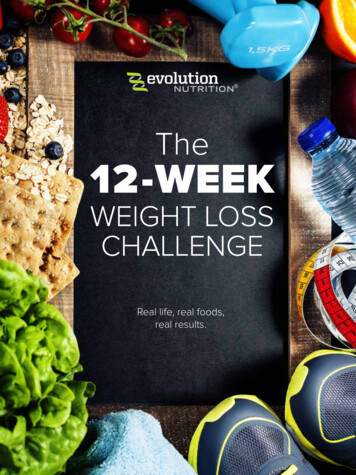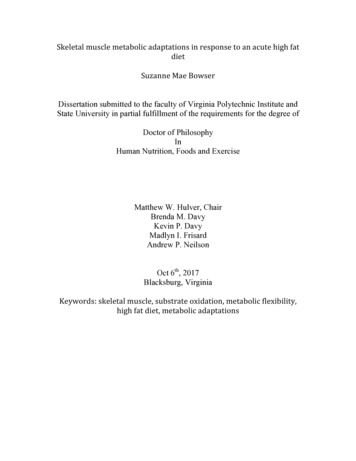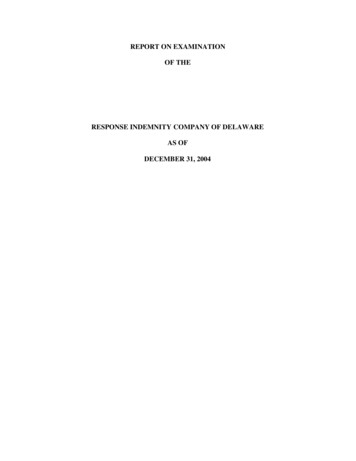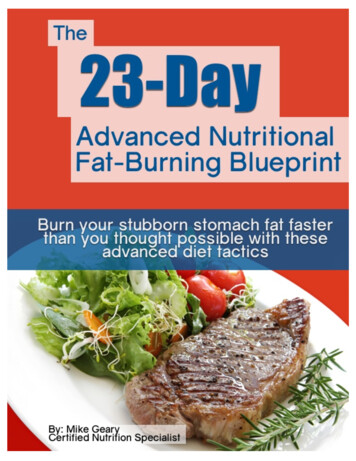
Transcription
JSHS121 proof 3 June 2014 1/8 MODELAvailable online at 3Journal of Sport and Health Science xx (2014) 1e8www.jshs.org.cnOriginal articleMetabolic response to 6-week aerobic exercise training and dieting inpreviously sedentary overweight and obese pre-menopausal women: Arandomized trialQ3Petri Wiklund a,b, Markku Alen b,c, Eveliina Munukka a, Shu Mei Cheng a, Bo Yu d, Satu Pekkala a,Sulin Cheng a,d,*baDepartment of Health Sciences, University of Jyväskylä, FI-40014 Jyväskylä, FinlandDepartment of Medical Rehabilitation, Oulu University Hospital, Oulu FI-90029 FinlandcInstitute of Health Sciences, University of Oulu, Oulu FI-90014 FinlanddSchool of Kinesiology, Shanghai University of Sport, Shanghai 200438, ChinaReceived 3 February 2014; revised 3 March 2014; accepted 11 March 2014AbstractBackground: The aim of this study was to compare 6 weeks short-term moderate intensity aerobic exercise and dieting on serum metabolomicsand cardio-metabolic risk factors in pre-menopausal women.Methods: Ninety previously inactive overweight and obese (BMI 25e35 kg/m2) women (age 41.5 7.6 years) were randomized to either a 6week Nordic walking exercise program (EX, n ¼ 45) or dietary counseling group (DI, n ¼ 45). Body composition, serum glucose, insulin andlipids were measured. Serum low-molecular-weight metabolites and lipid constituents were analyzed by nuclear magnetic resonance spectroscopy. Measurements were done at baseline and 7 days after the last training session.Results: Six weeks aerobic exercise program yielded reductions in serum free fatty acids ( 34.7%, 95% confidence interval (CI), 50 to 18,p 0.001), glucose ( 9.6%, 95% CI, 15 to 4, p 0.001) and homeostasis model assessment of insulin resistance (HOMA-IR) ( 28.7%,95% CI, 48 to 10, p ¼ 0.005) without changes in body weight or fat mass. Diet counseling resulted in loss of body weight (1.5%, 95% CI, 2.3 to 0.7, p ¼ 0.001) but no changes in free fatty acids, fasting glucose, or HOMA-IR were found.Conclusion: Our results indicate that small weight loss does not produce measurable health benefits, whereas short-term regular aerobic exercisecan improve glucose and lipid metabolism even in the absence of weight loss in previously sedentary overweight and obese women.Copyright Ó 2014, Shanghai University of Sport. Production and hosting by Elsevier B.V. All rights reserved.Keywords: Dieting; Exercise; Metabolism; Metabolomics; Women1. Introduction* Corresponding author. School of Kinesiology, Shanghai University of Sport,Shanghai 200438, China.E-mail address: shulin.cheng@jyu.fi (S. Cheng)Peer review under responsibility of Shanghai University of SportProduction and hosting by ElsevierThe modern way of life, characterized by abundance ofenergy-enriched foods coupled with sedentary lifestyles isassociated with increased obesity and cardiovascular disease(CVD).1 Although men and women are both vulnerable to theramifications of modern lifestyles, accumulating evidenceindicate that CVD affect more women than men.2 This phenomenon is generally attributed to the mounting toll of timesimply because women tend to live longer than men. However,another fact that may partly explain the greater cumulative2095-2546/ - see front matter Copyright Ó 2014, Shanghai University of Sport. Production and hosting by Elsevier B.V. All rights 013Please cite this article in press as: Wiklund P, et al., Metabolic response to 6-week aerobic exercise training and dieting in previously sedentary overweight andobese pre-menopausal women: A randomized trial, Journal of Sport and Health Science (2014), 128
JSHS121 proof 3 June 2014 2/8 5556575859606162636465impact of CVD among women is that women usually receiveless aggressive treatment for cardiovascular risk factors, andare less often referred to cardiac rehabilitation and CVDprevention programs than men.2,3 Such disparity relative tosex in patient care may partly be related to the misconceptionthat women are protected from CVD by estrogen.4 However,the cardio-protective effects of estrogen erode during menopause.5,6 Many women also tend to express more sedentarybehavior and reduction in leisure-time physical activity as theymove toward and beyond menopause.7,8 Therefore, overweightand obese women are at high risk to develop CVD as theyadvance from middle age to older years.A recent meta-analysis showed that insulin resistance,hyperinsulinemia and hyperglycaemia together with hypertriglyceridemia, low high-density lipoprotein cholesterol(HDL-C) and elevated low-density lipoprotein cholesterol(LDL-C) and central obesity, are associated with 2-fold increase in cardiovascular outcomes and a 1.5-fold increase inall-cause mortality.9 Recent studies have confirmed the benefits of long-term lifestyle changes on these cardiovascular andmetabolic risk factors,10,11 indicating that the impact of lifestyle decisions on cardiovascular and metabolic health iscrucial. However, whether the benefits of lifestyle modifications on reducing the risk of CVD are delivered through exercise or changes in dietary habits is not clear. It also remainsto be determined whether the benefits of exercise and dietingon cardio-metabolic health are visible in the short-term. Toaddress these questions we used nuclear magnetic resonance(NMR) -based metabolic profiling technologies for acquiringhigh throughput “snap shots” of a whole organism’s status12allowing the study of the molecular response to exercise anddieting.The objective of this study was to compare the effect of 6weeks short-term moderate intensity aerobic exercise programand diet counseling on cardio-metabolic risk factors and serummetabonomics in previously sedentary pre-menopausal overweight and obese women.2. Materials and methods2.1. Ethical approvalThe study protocol was approved by the ethical committeeof Central Finland Health Care District. Written informedconsents were obtained from all subjects prior to theassessments.2.2. Study designThe study subjects were recruited from Jyväskylä CentralFinland Health District/Health Promotion Hospital initiativeprogram. The study was conducted from May to November in2009. One hundred and sixty-one women (all hospital staff)responded to our invitation. Sample size was estimated fordifferent purposes on the primary outcome of the study results(such as physical fitness measured by walking test andmaximum oxygen uptake (VO2max), heart rate (HR)MODELP. Wiklund et al.variability, and insulin resistance). All the sample sizes willhave 85% power to detect differences with p 0.05 two-sidedsignificance level. Taking into account the compliance anddrop-out (10%), the total number of subjects was estimated tomeet each specific aims. One hundred and ten met thescreening criteria and were invited by phone or e-mail toparticipate in baseline measurements. A physician examinedthe physical condition of the subjects and ensured that subjectsmeet the inclusion criteria: 20e50 years old pre-menopausalwoman with a body mass index (BMI) between 25 and38 kg/m2 who participated regular exercise 2 times/weekand 45 min/time, and had no serious cardiovascular ormusculoskeletal problems, no diagnosed type I diabetes, andhad not lost or gained more than 5 kg in weight during theprevious 6 months. The eligible participants were randomizedinto parallel exercise (EX) or diet intervention (DI) groupsafter being enrolled to the study and the qualification beingchecked. A computer program (http://www.random.org/) wasused to generate the random number by blocks (50 numbers ineach block). The randomized number was assigned to thesubjects according to the order of enrollment. The randomization was done by a researcher that was blinded during thetrial and was unblinded at the conclusion of the trial. All maininvestigators in the project were also blinded until the end ofthe intervention. The flow chart of the study participants isgiven in Fig. 1. Ninety women started intervention (n ¼ 45 inthe exercise group (EX) and n ¼ 45 in the diet group (DI)).Eighty-three women completed the 6-week intervention andhad follow-up measurements (39 in the EX and 44 in the DI).The study was registered in International Standard Randomized Controlled Trial Number Register (ISRCTN87529813).Full trial protocol is available online 529813).2.3. Background information and anthropometricsBackground information including medical history andcurrent health status was collected via self-administeredquestionnaires. Food consumption and intakes of total energy and energy-yielding nutrients were assessed from 3-dayfood records at baseline and at the end of the study andanalyzed using Micro-Nutrica software developed by the Social Insurance Institution of Finland and updated with data fornew foodstuffs by the study nutritionist.13Height was determined using a wall-fixed measuring device, and body mass using a calibrated scale, and from theseBMI, which is expressed as (weight (kg)/height2(m2)), wascalculated. Body composition was assessed using a bioelectrical impedance analysis device (Inbody 720; Biospace Co.Ltd. Seoul, South Korea). Inbody is a multifrequency impedance plethysmograph body composition analyzer, which takesreadings from the body using an 8-point tactile electrodemethod. It measures the resistance at five specific frequencies(1 kHz, 50 kHz, 250 kHz, 500 kHz, and 1 MHz) and reactanceat three specific frequencies (5 kHz, 50 kHz, and 250 kHz).Total body water (TBW) was estimated from area, volume,length, impedance, and a constant proportion (specificPlease cite this article in press as: Wiklund P, et al., Metabolic response to 6-week aerobic exercise training and dieting in previously sedentary overweight andobese pre-menopausal women: A randomized trial, Journal of Sport and Health Science (2014), 29130
JSHS121 proof 3 June 2014 3/8 MODELMetabolic response to exercise and dieting in 53545556575859606162636465resistivity). Fat free mass (FFM) was estimated by dividingTBW by 0.73, and the fat mass (FM) was calculated by subtracting the FFM from the body weight. Precision of therepeated measurements of FM expressed as coefficient ofvariation was on average 0.6%. Subjects were measured in themorning after 12-h fasting. Before the measurement, subjectswere asked to excrete and refrain from drinking excessiveamounts of water.2.4. Blood samplesVenous blood samples for biochemical analyses were takenin standardized fasting conditions in the mornings between37:00 am and 9:00 am before and after intervention. Serumsamples were stored frozen at 80 C until analyzed. Serumconcentrations of glucose, total and HDL cholesterol, triacylglycerol and non-esterified fatty acids (NEFA) wereanalyzed using the KONELAB 20XTi analyzer (ThermoFischer Scientific inc., Waltham, MA, USA). LDL cholesterolwas calculated using the Friedewald equation.14 Serum fastinginsulin concentrations were analyzed using the IMMULITE1000 analyzer (Siemens Healthcare diagnostics, Mannheim,Germany). The homeostasis model assessment of insulinresistance (HOMA-IR) index was calculated as (fasting insulinconcentration fasting glucose concentration)/22.5.15 Serumleptin and adiponectin were measured by ELISA (DuoSetÒ;R&D Systems, Minneapolis, MN, USA). The interleukin-6(IL-6) and interleukin-8 (IL-8) concentrations weremeasured from the serum samples using Cytokine Bead Array(CBA) Flex Sets kit (BD Biosciences, San Diego, CA, USA)and a flow cytometer (FACSCalibur; BD Biosciences) according to the manufacturer’s instructions. The data wereanalyzed by using FCAP Array software (BD Biosciences).All measurements were performed after 12 h fasting at baseline and 7 days after the last training session to minimize anyacute effects of exercise.2.5. Serum NMR metabonomicsAll serum samples were analyzed using a high-throughputserum NMR metabonomics platform; the experimental protocols including sample preparation and NMR spectroscopyhave been described in detail elsewhere.12,16,17 This platformprovides comprehensive quantitative information on lipoprotein subclass concentrations, low-molecular-weight metabolites such as amino acids, ketone bodies, and gluconeogenicintermediates and detailed molecular information on serumlipids including, e.g., U-3 and U-6 fatty acids. This platformhas recently been applied in various large-scale epidemiological and genetic studies.18e212.6. Fitness testVO2max (mL/kg/min) was assessed by a bicycle ergometerunder the supervision of a physician. The test began with a 2min warm-up at 50 W. After that the intensity was increasedby 25 W at 2-min intervals until exhaustion. Electrocardiography was monitored and continuously and HR and maximalwork load were recorded at the end of every load. Oxygenuptake was assessed by breath-by-breath method using respiratory gas analyzer (Sensor Medics Vmax, Yorba Linda, CA,USA). Maximal oxygen uptake was reached, when measuredVO2 reached a plateau or started to decrease or subject felt shehad reached her maximal level and wanted to stop the test.2.7. Exercise programFig. 1. Flow-chart of the study participants.Nordic walking (walking with poles) was chosen as theintervention exercise. A specific training program was developed after baseline assessments on the basis of each individual’sPlease cite this article in press as: Wiklund P, et al., Metabolic response to 6-week aerobic exercise training and dieting in previously sedentary overweight andobese pre-menopausal women: A randomized trial, Journal of Sport and Health Science (2014), 29130
JSHS121 proof 3 June 2014 4/8 253545556575859606162636465P. Wiklund et al.maximum HR measured during the VO2max test. The exerciseprogram was progressive based on the recommendation forsedentary adults. For intervention week 1, the intensity of exercise was 60% of maximum HR, for 60 min per session and 3times a week; for intervention weeks 2 and 3 the intensity ofexercise was 65% of maximum HR for 45 min per time and 4times a week; for intervention weeks 4 and 5, the intensity ofexercise was 70% of maximum HR for 35 min per session and 4times a week; and for intervention week 6, the intensity of exercise was 75% of maximum HR for 30 min per session and 3times a week. Nordic walking was supervised at the beginningof the intervention (week 1). From week 1 onwards subjectsfollowed the daily guidance of the wrist computer (Suunto Oy;Fitness line, Vantaa, Finland) to exercise 30 min to 1 h a time andgradually increase the intensity and duration and participated insupervised exercise sessions twice per week.2.8. Dietary interventionThe DI group received dietary instruction from a clinicalnutritionist according to the guidelines of Finnish nutritionrecommendations targeting to lose 3 kg of body weight in 6weeks (National Nutrition Council 2005). The instructionincluded controlling energy intake by reducing portion sizeusing the plate model; controlling meal rhythm and regulareating between 3 and 4 h intervals; changing the compositionof food stuffs including using light margarine (less than 40%fat) and vegetable oils, low-fat milk products, low-fat meatproducts and fish, light bakery products, increasing fiber intakeusing whole-wheat products, vegetables, root vegetables,berries, fruits, and avoiding products rich in sugar; drinking1.5e2 L of water/day, mineral water, mild juices, light beverages, coffee, and tea, and moderating alcohol consumption,preferably of mildly alcoholic drinks only. In addition, subjects in the DI group were instructed to maintain their habitualphysical activity but no specific exercise program was provided during the intervention.2.9. Statistical analysesAll data were checked for normality using the ShapiroeWilk’s W test in SPSS 15.0 for Windows (SPSS Inc.,Chicago, IL, USA). If data were not normally distributed, anatural logarithm transform was applied. An intention-to-treat(ITT) analysis was performed to compare the EX to the DIgroup. The effects of the interventions were assessed usinganalysis of covariance (ANCOVA) for repeated measures(treatment group time) with baseline values as a covariate.Table 1Subject characteristics at baseline and after intervention (intention to treat) (mean SD).EX (n ¼ 39)VariableBaselineAnthropometryAge (years)Height (cm)Weight (kg)Fat mass (kg)VFA (cm2)Fat free mass (kg)BMI (kg/m2)MetabolicGLUC (mmol/L)INS (mU/l)HOMA-IRCHOLtot (mmol/L)LDL (mmol/L)HDL (mmol/L)FFA (mmol/L)Trigly (mmol/L)Leptin (ng/mL)Adiponectin (mg/mL)IL-6 (pg/mL)IL-8 (pg/mL)DietEnergy (kcal/day)Protein (E%)Fat (E%)Carbohydrate (E%)FitnessVO2max (mL/kg/min)yBaseline DEX vs. 124.651.330.8 0.350.228.4 7.36.28.16.018.25.22.1ee78.328.4117.849.928.3 .31.84.92.61.54651.247.57.94.99.6 .11.63061.244.48.55.29.3 .43.01.44851.455.57.15.09.7 3.41.44211.448.48.15.29.4 0.74.81.00.90.70.41640.522.1y4.1y0.72.1 0.001NS0.010NSNSNS 0.001NSNSNSNSNS172418.334.145.4 4654.29.17.9164418.134.245.6 3392.54.55.3177919.132.547.5 4652.77.99.3165617.732.847.3 3142.24.34.7NSNSNSNS31.6 4.7NS32.2 4.9zDI (n ¼ 44)Follow-up32.5 5.230.4 5.5*p 0.05, p 0.01, p 0.001, compared to baseline within group; p 0.05, compared to exercise group baseline.Abbreviations: VFA ¼ visceral fat area, BMI ¼ body mass index, GLUC ¼ fasting glucose, INS ¼ insulin, HOMA-IR ¼ homeostasis model assessment of insulinresistance; CHOLtot ¼ total cholesterol; LDL ¼ low density lipoprotein; HDL ¼ high density lipoprotein; FFA ¼ free fatty acids; VO2max ¼ maximum oxygenuptake; EX ¼ exercise group; DI ¼ diet group; D ¼ change.aPlease cite this article in press as: Wiklund P, et al., Metabolic response to 6-week aerobic exercise training and dieting in previously sedentary overweight andobese pre-menopausal women: A randomized trial, Journal of Sport and Health Science (2014), 29130
JSHS121 proof 3 June 2014 5/8 MODELMetabolic response to exercise and dieting in 535455565758596061626364655Table 2Serum low-molecular-weight metabolites and lipid constituents at baseline and after intervention (intention to treat) (mean SD).VariableEX (n ¼ 39)BaselineLow-molecular-weight a-1-acid glycoprotein3-HB/aceALactate/pyruvateLipid exctract constituentsE-cholF-cholU-3 fatty acidsU-6 fatty acidsU-7, 9 fatty acidsLinoleic acidDHAPUFAMUFAPGtotPCtotSPHDI (n ¼ 44)Follow-upBaselineDEX vs. .080.050.070.090.090.060.290.081.791.8613.9 71.8313.0 091.891.8811.3 .002.022.0018.2 3.10.182.03.40.92.20.4 7.33.20.192.13.50.92.20.4 7.43.20.172.13.60.92.30.4 7.83.30.212.33.71.02.30.4 SNSNSNSNSNSNSNS*p 0.05, yp 0.01, zp 0.001, compared to baseline within group; ap 0.05, compared to exercise group baseline.Note: Metabolite concentrations are in mmol/L unless stated otherwise.Abbreviations: 3-HB ¼ 3-hydroxybutyrate; 3-HB/aceA ¼ 3-hydroxybutyrate to acetoacetate ratio; E-chol ¼ esterified cholesterol; F-chol ¼ free cholesterol;DHA ¼ docosahexaenoic acid; PUFA ¼ polyunsaturated fatty acids; MUFA ¼ monounsaturated fatty acids; PGtot ¼ total phosphoglycerides; PCtot ¼ totalphosphatidylcholines; SPH ¼ sphingomyelines; EX ¼ exercise group; DI ¼ diet group; D ¼ change.In addition to the ITT analysis, efficacy analysis was performed. Among the 83 women who had both baseline andfollow-up assessments, 21 were excluded from the efficacyanalysis due to the following reasons: in EX group, notcompleting at least 70% of exercise training (n ¼ 5), and morethan 2 weeks delay in participating in the follow-up assessments (n ¼ 3); in the DI group, flu or other illness (n ¼ 7) andmore than 2 weeks delay in participating in the follow-upassessments (n ¼ 6). The percentage changes from baselineto follow-up were calculated and the comparison of percentagechanges in different groups was performed using t tests. Thedata are presented as mean SD. The level of statisticalsignificance chosen for the comparisons was p 0.05.3. ResultsAt baseline, the DI group weighed more, had greater fatmass, visceral fat area, BMI, and leptin compared to the EXFig. 2. Mean changes of body composition (efficacy analysis) in women in theexercise (n ¼ 31, solid line) and dietary counseling (n ¼ 31, dotted line)groups. Squares represent mean values and lines indicate 95% confidenceinterval. *p 0.05 compared to diet group.Please cite this article in press as: Wiklund P, et al., Metabolic response to 6-week aerobic exercise training and dieting in previously sedentary overweight andobese pre-menopausal women: A randomized trial, Journal of Sport and Health Science (2014), 29130
JSHS121 proof 3 June 2014 6/8 253545556575859606162636465P. Wiklund et al.(23%, p ¼ 0.003) increased significantly in the DI groupcompared to the EX group (Fig. 4).4. DiscussionFig. 3. Mean changes of metabolic measures (efficacy analysis) in women inthe exercise (n ¼ 31, solid line) and dietary counseling (n ¼ 31, dotted line)groups. Squares represent mean values and lines indicate 95% confidenceinterval. *p 0.05, zp 0.001 compared to diet group. FFA ¼ free fatty acids,CHOLtot ¼ total cholesterol, LDL ¼ low density lipoprotein, HDL ¼ highdensity lipoprotein.The main findings of this study were that 6 weeks ofmoderate intensity aerobic exercise in previously sedentaryoverweight and obese premenopausal women was associatedwith significant reductions in serum free fatty acid, glucose,and HOMA-IR, without change in body weight, while 6 weeksof dietary counseling resulted in a small degree of weight losswith no observable improvements in glucose or lipidmetabolism.Lifestyle interventions have been shown to be useful toolsin treating cardio-metabolic disorders in pre-menopausal andpost-menopausal women.22e24 Limited research on the effectsof hormone replacement therapy (HRT) and exercise on CVDrisk factors in healthy post-menopausal women show thatexercise and HRT have both independent and complimentarygroup (all p 0.05, Table 1). The DI group also had higher a1-acid glycoprotein, pyruvate, isoleucine, leucine, phenylalanine, tyrosine, pyruvate levels at baseline (all p 0.05, Table2). No differences in serum lipids, glucose, cytokines, aerobicfitness or dietary intake between groups were found.3.1. Intention to treatAfter 6 weeks intervention serum free fatty acids, glucoseand HOMA-IR were significantly reduced in the EX groupcompared to the DI group ( p 0.05 for all, Table 1). Nosignificant differences (group by time interaction) in bodyweight, fat mass, visceral fat area and BMI were observed.Serum acetate, pyruvate and decreased and lactate, glutamine,lactate to pyruvate ratio, U-3 fatty acids, polyunsaturated fattyacids and DHA increased in the DI group but not in EX groupwith time, and did not show significant group-by-time differences, except for glutamine and lactate to pyruvate ratio( p ¼ 0.041 and p ¼ 0.007, Table 2). Tyrosine increased in theEX group but not in the DI group with time while phenylalanine, histidine, glycine, and a-1-acid glycoprotein increasedsignificantly in both groups over time but no significant groupby time differences were found.3.2. Efficacy analysisBody weight decreased (on average 1 kg) significantly inthe DI group compared to the EX group ( p 0.05, Fig. 2),while significant reduction (group-by-time) in serum free fattyacids (27.6%, p 0.001), glucose (11.1%, p 0.001) andHOMA-IR (21.2%, p ¼ 0.021) was observed in the EX group(Fig. 3). DHA (26.3%, p ¼ 0.001) and lactate to pyruvate ratioFig. 4. Mean changes of serum metabolites (efficacy analysis) in women in theexercise (n ¼ 31, solid line) and dietary counseling (n ¼ 31, dotted line).Squares represent mean values and lines indicate 95% confidence interval.*p 0.05, yp 0.01 compared to exercise group. 3-HB ¼ 3-hydroxybutyrate;3-HB/AceA ¼ 3-hydroxybutyrate to acetoacetate ratio; E-chol ¼ esterifiedcholesterol; F-chol ¼ free cholesterol; DHA ¼ docosahexaenoic acid;PUFA ¼ polyunsaturated fatty acids; MUFA ¼ monounsaturated fatty acids.Please cite this article in press as: Wiklund P, et al., Metabolic response to 6-week aerobic exercise training and dieting in previously sedentary overweight andobese pre-menopausal women: A randomized trial, Journal of Sport and Health Science (2014), 29130
JSHS121 proof 3 June 2014 7/8 MODELMetabolic response to exercise and dieting in 53545556575859606162636465effects on body composition and serum lipid profiles.25e27 Thediscrepancy may be due to differences in the type, amount andintensity of exercise and low sample sizes.28 Nevertheless,recent studies suggest that with regard to lifestyle interventions, the greatest benefits arise from combined programs of exercise and dieting for both pre-29,30 and postmenopausal women.31,32 These health benefits seem to beattributed to weight loss achieved in the course of severalmonths or years.33,34 In the present study, DI group failed toachieve the targeted reduction of 3 kg of body weight in 6weeks. As a result, no significant improvements in cardiometabolic risk factors were observed, suggesting that lifestyle intervention using only dietary approaches may needconsiderably more significant energy restriction and longerduration in order to induce favorable changes in body weightand cardio-metabolic health. Exercise training, however,resulted in significant reduction in free fatty acids, glucose,and HOMA-IR in the absence of weight loss.These findings are in agreement with a previous study, thatshowed short-term (4 weeks) aerobic exercise decreasedcirculating free fatty acids without weight loss in previouslysedentary obese men and pre-menopausal women.35 In thatstudy, significant decrease in hepatic and visceral lipids wasalso observed, indicating that short-term aerobic exercise canmitigate cardiovascular risk and this is not contingent uponweight loss. In the present study, we did not measure hepaticcontent but exercise training tended to result in reduction invisceral fat. Therefore, we cannot rule out that reduction inhepatic and visceral fat may have contributed to the reductionof free fatty acids, glucose, and insulin resistance in the EXgroup. However, dieting resulted in reduction in visceral fatwithout concurrent changes in either lipid or glucose metabolism. These observations do not support the notion thatreduction in free fatty acids and insulin resistance with in EXgroup was attributed to reduction of visceral fat.To delineate the metabolic shifts underlying our observations we performed NMR-based serum metabolomics analysis.However, given the significant reduction in serum fatty
Background: The aim of this study was to compare 6 weeks short-term moderate intensity aerobic exercise and dieting on serum metabolomics and cardio-metabolic risk factors in pre-menopausal women. Methods: Ninety previously inactive overweight and obese (BMI 25e35 kg/m 2 )










